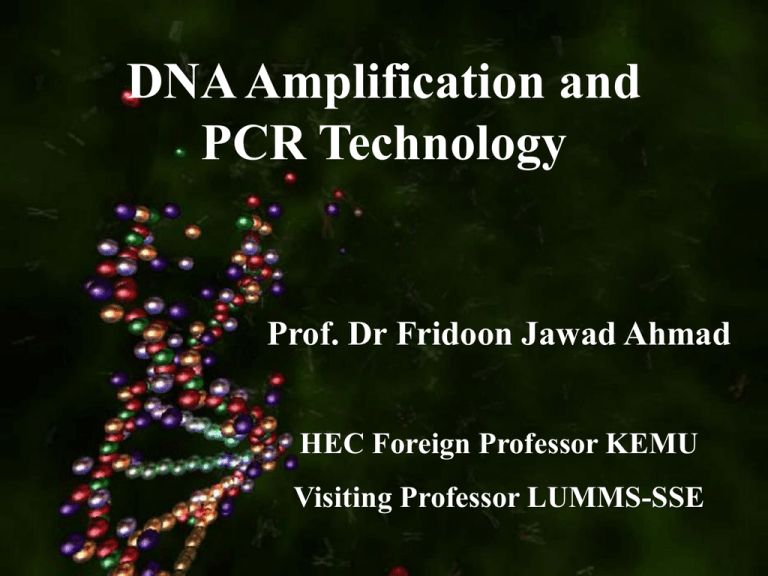Theory of PCR and its Applications (Professor Fridoon)
advertisement

DNA Amplification and PCR Technology Prof. Dr Fridoon Jawad Ahmad HEC Foreign Professor KEMU Visiting Professor LUMMS-SSE Uses of Amplified DNA • SEQUENCING: Sequencing determines the base pair sequence of a gene. By reading the 3-letter code, sequencing also describes the AMINO ACID SEQUENCE translated from that gene. • MUTATION: It is possible to study the effects of SINGLE AMINO ACID CHANGES on the function of the gene product, which is, after all, the ultimate purpose of the exercise (reverse genetics). • MASS PRODUCTION OF PROTEINS: To use the amplified gene to make HUMONGOUS QUANTITIES of the GENE PRODUCT for commercial purposes. • TRANSGENICS: INSERT the gene into ANOTHER SPECIES. • Gene Therapy The DNA Analysis Dilemma • Genomes are composed of large DNA chunks on the order of millions of units. • When scientists first considered studying genomes they were faced with a problem: how to reproducibly cut a genome’s DNA into fragments that were small enough to handle? • Scientist can only handle pieces of DNA a few thousand units long • Random cutting using chemical or mechanical means was not a satisfactory way to obtain smaller pieces of DNA. • It was impossible to tell what the original order of the DNA fragments were. Restriction Endonucleases • It was discovered that a type of bacterial enzyme was found to have the ability to cut DNA in a test tube. • These restriction endonucleases, cut double stranded DNA at specific sites. • In a bacterial cell, restriction endonucleases (restriction enzymes) act as a kind of immune system, protecting the cell from the invasion of foreign DNA (virus). • Many recombinant DNA technologies, which the field of biotechnology heavily relies on, are unlikely to have been developed without the discovery of restriction enzymes The Discovery Werner Arber, Daniel Nathans and Hamilton Smith (1978 Nobel Prize) Restriction Sites • Palindromic Sequences: A palindromic sequence is the same when read in 5′ to 3′ direction on either complementary strand of DNA. GTAATG DENNIS SINNED VS GTATAC Blunt Ends Sticky Ends Ligase/ Endonuclease The Steps In Genetic Engineering Many Proteins Collaborate at The Replication fork The Mechanisms of DNA Replication Requirements of DNA Replication 1. Template (Single stranded DNA) 2. Enzymatic Activity (DNA Polymerase) 3. Initiator (Primer/3’ hydroxyl group) 4. Spare parts (Nucleotide tri-phosphates) Fourteen DNA Polymerases have been identified in humans and three in bacteria PCR Technique and Applications The Inventor Kary Mullis The idea for PCR is credited to Kary Mullis who was a research scientist in the 1980s at a California biotechnology company called Cetus (bought out by Chiron). Mullis, and five other researchers in the Human Genetics Department at Cetus, demonstrated that oligonucleotide primers could be used to specifically amplify defined segments of genomic DNA (or cDNA). Mullis was co-winner of 1993 Nobel Prize in Chemistry. Biochemistry of the Polymerase Chain Reaction The logic of the PCR protocol follows directly from well-understood principles of nucleic acid biochemistry. The basic components of a PCR reaction are: - one or more molecules of target DNA - two oligonucleotide primers - thermostable DNA polymerase - dNTPs Animation Now & Then The PCR Amplification Cycle Each PCR cycle requires three temperature steps to complete one round of DNA synthesis. Before cycle 1 can be initiated, the double-stranded DNA target needs to be heat-denatured to provide single-stranded regions for primer annealing. The temperature profile of a PCR cycle is controlled by the thermal cycler program Exponential Amplification Cycles 1 2 4 10 15 20 25 30 Copies 2 4 16 1,024 32,768 1,048,576 33,554,432 1,073,741,824 Detection of PCR Product Animation Applications of PCR technology Disease Detection Many pathogens can be detected from a small sample e.g. Isolation and detection of HCV RNA from whole blood HCV HBV HIV Adenoviruses Influenza virus Cytomegalovirus etc DNA Finger Printing in Paternity DNA Finger Printing in Crime Investigation Real Time PCR (RT-PCR) primer 1. PCR primers 1 and 2 and a TaqMan probe,labelled with a reporter dye, (R) and a quencher dye, (Q), bind to the DNA template. 2. The 3' phosphate group (P) prevents extension of the TaqMan probe. 3. The presence of the enzyme,Taq polymerase, enables extension of the primer which displaces the TaqMan probe. 4. The displaced probe is cleaved by Taq DNA polymerase resulting in an increase in relative fluorescence of the reporter. 5. Polymerisation is now complete. Real Time PCR (RT-PCR) DNA Sequencing Customized Medicine




